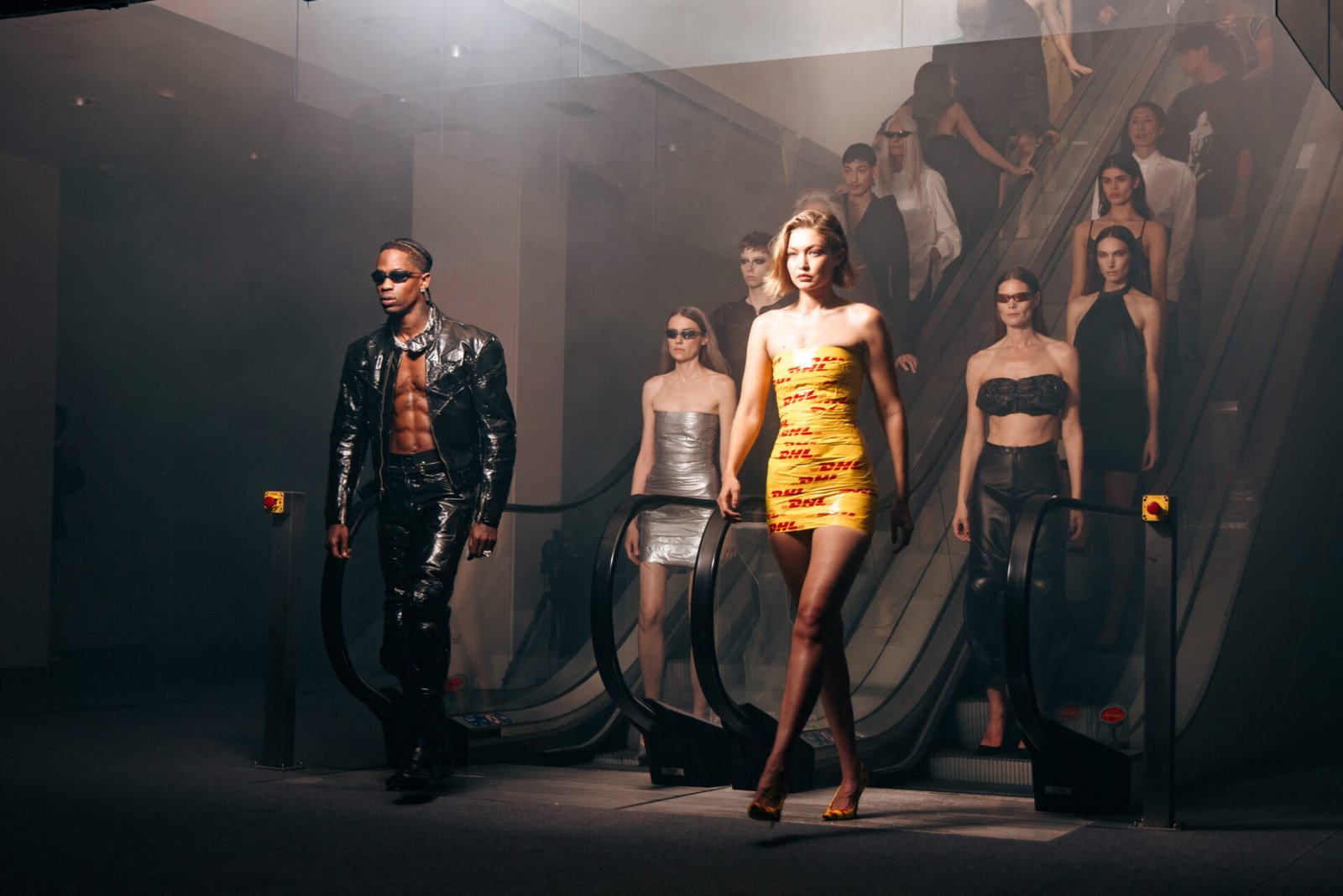Fashion weeks (pictured: runway scene at the bottom) are synonymous with glamour and creativity, but beneath the surface lies a harsh reality. Creative teams – including costume designers, stylists, set builders, assistants and models – often endure long hours, poor pay and abusive treatment. Investigations show that this “wealthy industry” frequently relies on free or underpaid labor, exploiting the very talent that creates its image. Luxury brands market the prestige of couture fashion, yet expose a hidden supply chain of injustice through exploitation of costume designers.
Fashion journalists and researchers have documented this gap between image and reality. Academic Giulia Mensitieri (quoted in The Fashion Law) found that fashion is “an extremely wealthy industry founded on unpaid work”. In France, Italy, the US and beyond, companies boast of craftsmanship and social responsibility, even while using subcontractors that “employed workers who would receive inadequate wages, [and] work hours in excess of the legal limit.
In India, entire communities of home-based artisans and factory workers toil for pennies. Yet these essential contributors remain invisible as the industry’s public face stays polished.
The Global Context: Fashion’s Hidden Labor Toll and Exploitation Of Costume Designers
Fast fashion and major runway events depend on millions of human hands. An Earth Day report notes that around 60 million garment workers worldwide fuel the industry, yet “less than 2% earn a living wage”. Many endure unsafe conditions, wage theft, exhausting hours and gender-based harassment.
The deadly 2013 Rana Plaza collapse in Bangladesh, which killed 1,134 garment workers, painfully reminded the world of these abuses. Although Rana Plaza focused on factory manufacturing, similar pressures affect the creative side of shows – from laboring backstage to crafting intricate costumes.
The structural dynamics of fashion exacerbate exploitation. As Mensitieri observes, the more prestigious or artistic a job is deemed, the less it tends to be paid. High-fashion runway assistants and costume designers are often asked to work for “exposure,” enduring overlong shifts for free clothes instead of wages. In many cases, interns or freelancers vastly outnumber paid staff – as one former intern at Alexander McQueen recalled, there were “10 interns and only five paid staff” in core departments.
This reliance on unpaid labor is global: in the US and UK up to 75–80% of fashion creatives (stylists, makeup artists, photographers, etc.) work freelance, yet they lack basic labor protections.
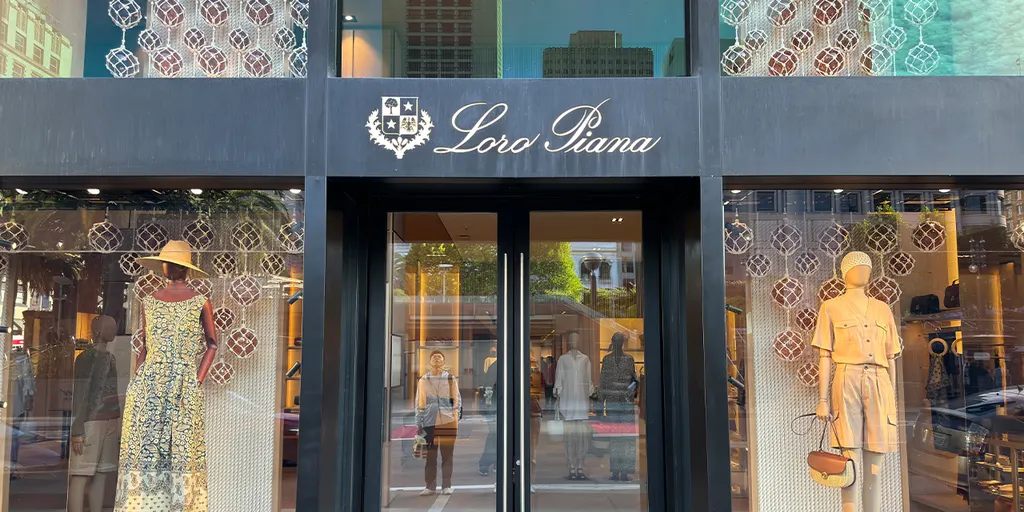
While brands highlight artisanal craft, probes found “Chinese workshops” supplying big names like Dior and Armani with laborers paid just €4 per hour for 90-hour weeks. Italian authorities have launched formal investigations: Milan regulators charged Christian Dior Italia and Giorgio Armani’s groups with unfair practices for using suppliers who broke labor laws.
Italy’s case illustrates the global pattern: major luxury firms publicize ethical values, then source production to hidden subcontractors with abusive conditions. A Le Monde report details how Armani and Dior allegedly emphasized “craftsmanship and quality” in marketing, while their clothing was made by workshops where workers labored beyond legal limits for paltry pay. Dior and Armani have denied wrongdoing, but regulators note that the companies themselves came under judicial administration when exploitative subcontracting was uncovered.
A Tale of Two Sides: Statements vs. Reality in Italy
In Italy’s fashion sector, contradictions are stark. On one side, executives tout Made in Italy and humane working standards; on the other, court findings reveal “Chinese-owned factories” and dormitories for undocumented labor on Dior and Armani supply lines. Reporter Ritu Upadhyay notes that even an award for sustainability at Milan Fashion Week (granted to Tod’s in 2025) occurred amid a backdrop of labor abuse probes.
Meanwhile, Elle India reports that when Loro Piana’s President refused to comment on an investigation into rampant exploitation, a rights activist quipped: “Luxury brands often highlight how long it took to weave a piece, but who ensures those hours were fairly compensated?”. Influencer and activist Rishija Mehrotra underlined that asking the right questions is crucial: “Until we ask those questions, empowerment remains an idea, not a practice.”
Workers themselves describe hidden hardship. On Chinese-run factories in Veneto (northeast Italy), men work side-by-side cutting leather for Italian labels. A photo from Elle India shows a cramped workshop – deceptive given the high-end image of the products.
Workers themselves describe hidden hardship. On Chinese-run factories in Veneto (northeast Italy), men work side-by-side cutting leather for Italian labels. A photo from Elle India shows a cramped workshop – deceptive given the high-end image of the products.
Survivors and NGO reports detail children and migrants stitching in basements; one 2025 investigation found a 10-year-old among garment workers in India who supplied export chains. Even in the polished runway environment, reality creeps in. At a Paris show, Kanye West’s spectacle was praised for its provocative art, yet critics noted the irony: “What’s the difference?… what he represents… actively supports economic slavery.”. As photojournalist Mike Abu (Vice) pithily summarized, fashion week success often sits on “economic slavery.”.
Creative Labor in the US and Europe: Free Work and Abuse
In major fashion capitals like New York and London, creatives—costume designers, stylists, assistants and interns—face routine exploitation. New York-based model and filmmaker Sara Ziff, who founded the labor advocacy group Model Alliance, has long exposed that many fashion participants start their careers unpaid. Models, for instance, often work only for clothes or late checks.
In a famous 2012 essay, Ziff noted that “of the models who achieve a coveted spot walking in New York Fashion Week, many… are never paid at all; instead, [they are] working for free or for clothes”. The U.S. has since seen campaigners push the Fashion Workers Act, a proposed law to guarantee wage transparency and end some abuses. A Fox News report covered Model Alliance activists outside the 2023 Met Gala: one model, Rozi Levine, said “Sometimes models are paid in clothing, if anything at all”, highlighting how even high-profile participants lack basic protections.
Beyond models, other creative roles are similarly unprotected. In the UK and US, the vast majority of fashion industry workers are “independent contractors” without sick leave or insurance. Vogue Business notes that 75% of art and design workers in the US are freelancers. These workers have no guaranteed pay, yet “are part of one of the least protected” sectors.
Pandemic-era reviews urged governments to extend unemployment and sick benefits to freelancers. Still, the underlying exploit persists: stylists and costume designers frequently work for free exposure. FashionLaw reports on Italian stylists flown in first-class to Chanel shows who “never knew when [they] would be paid”, sometimes receiving only gift vouchers.
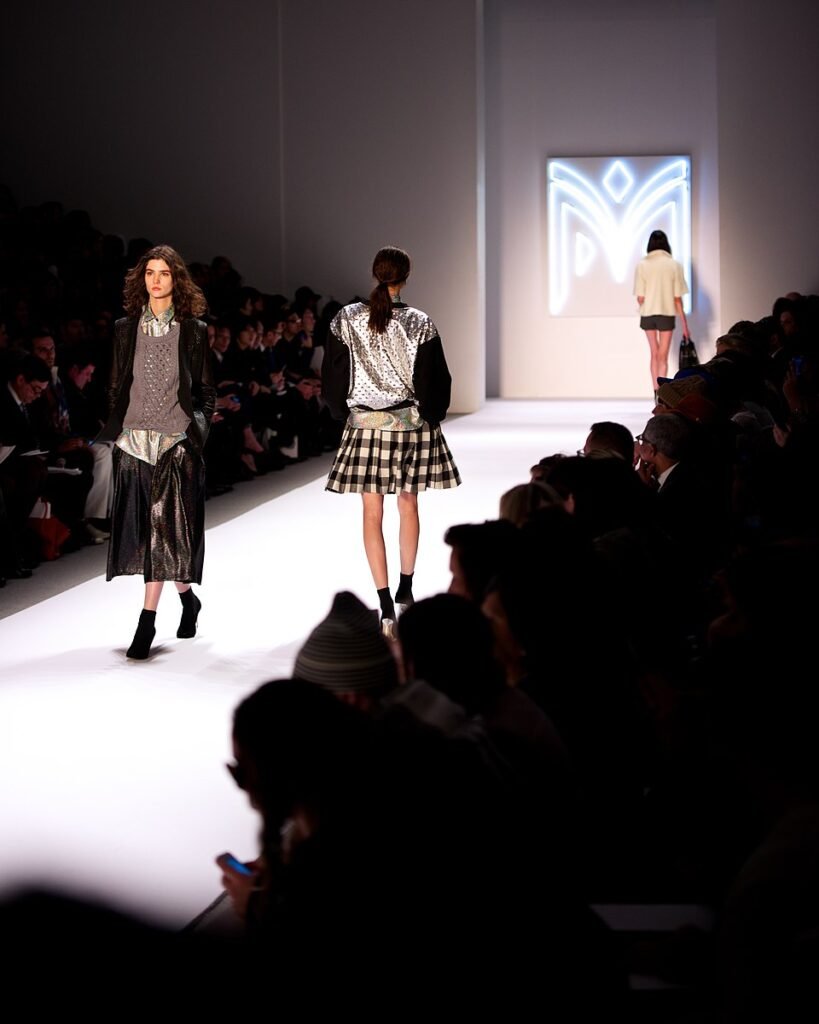
Major shows mask this imbalance. Models strut the catwalk, photographed by the world’s press, while behind them, creative crews scramble for scraps. Reality comes out in personal accounts: a 2018 New York Refinery29 story documented anonymous fashion assistants sharing horror stories on Instagram. Interns recounted being yelled at to work all night then show up at dawn with no breaks.
Stylists have told of being verbally abused on set (hit with shoes or told to starve). As journalist Jo Ellison wrote, abuse in fashion isn’t limited to sexual harassment; “the perpetrators tend to be women and the abuse is usually verbal or physical,” with frustrated creatives bullying underlings for minor mishaps. In short, working in fashion’s spotlight can mean tolerating abuse as part of the job.
Even the law struggles to catch up. In London, a 2010 Guardian investigation highlighted unpaid fashion internships: one intern at Alexander McQueen said “I worked from 8.30 in the morning until at least 2am” almost daily, seven days a week, sewing thousands of sequins on ball gowns. Legal experts pointed out that such arrangements likely violate minimum wage laws. The intern cited, Rufus Cassidy, eventually quit unpaid.
Although UK law technically forbids such exploitation, enforcement is weak. Similarly in the U.S., models and stylists often must litigate or unionize for basic wages. In New York, the failure of employers to pay models or to clarify contracts spurred the Fashion Workers Act campaign. As New York State Senator Brad Hoylman noted, “it makes no sense that [fashion workers] aren’t protected”. Still, until legislation passes, many rely on personal risk: one model remarked “We have no basic labor protections. Wages are stolen, [and we] wait months for paychecks”.
India’s Runways: Lakme Fashion Week and Hidden Costs
In India, the world’s second-largest garment producer, fast fashion and high-profile events also carry a human cost. Lakme Fashion Week in Mumbai is India’s premier runway event, but even here exploitation has surfaced. Unlike Western shows, Indian fashion weeks often bill themselves as launching pads for new talent, yet participants (models, designers, assistants) routinely work unpaid.
A 2018 Mumbai Mirror report spotlighted plus-size models – a group that should symbolize inclusivity – speaking out about exploitation. Neha Parulkar, a veteran plus-size runway model, revealed “I have never been paid” to walk in Lakme Fashion Week shows. Other models were told to buy their own outfits and accessories for shows.
As one complained, designers’ attitude is “If you don’t want to do it, we will get someone else, but we won’t pay you”. The collage above shows Lakme runway participants with quotes from their testimonies – powerful evidence that “diversity” is empty if workers aren’t compensated.
Many were expected to walk the runway for free, told “you don’t have to be paid” for promoting diversity.
These statements, on image captions, illustrate how commercial pressure trumps fair pay.
Beyond runways, India’s artisanal heritage is exploited by top fashion brands. A July 2025 Elle India feature by Rituparna Chatterjee revealed that “artisans are the invisible backbone” of luxury; weavers and embroiderers supply major houses, often working 90-hour weeks for next-to-nothing.
Take the case of Loro Piana: Italian luxury brand shoppers enjoy cashmere and leather, unaware that downstream, a network of contractors has offshored production to the tropics. Investigators found Loro Piana was buying goods from Indian markets where supply chain abuse was rampant. In Gujarat and Tamil Nadu, home-based stitchers earn fractions of a rupee per piece.
One Chennai seamstress explained that working at home keeps her earning “very low wages” compared to factory work, but she had no choice while caring for children. As Siddharth Kara (academic and anti-trafficking expert) noted, the global demand for cheap apparel comes at the expense of these “penny-wage and exploitation” in India. Approximately 19% of surveyed workers were minors (10–18 years old). Yet even as India strengthens labor laws, the informal, decentralized nature of garment work makes abuse hard to track.
A local labor official commented in 2019 that home-based garment labor exploitation is “rampant,” prompting India’s government to plan a census of unorganized workers. Brands (often foreign) that source textiles from India must now reckon with this hidden human cost. The Lakme Fashion Week itself occasionally highlights ethical fashion lines – but insiders warn that glamorous shows can overshadow garment workers’ plight. One organizer at a 2025 show expressed concern that “until someone monitors the hours and pay in the ateliers, our talk of empowerment is just PR.”This echoes Rishija Mehrotra’s critique.
Voices from the Backstage: Testimonies and Expert Opinions
To understand the human impact, we turn to firsthand accounts. Models, designers, artisans and legal experts have spoken out. For instance, at a 2023 New York protest, model Rozi Levine (Model Alliance) called out the lack of pay: “Sometimes we get paid in clothing – if anything at all,” she told reporters. In London, early-career fashion assistant Charlotte (name changed) confided via Refinery29 that working for a top stylist left her “afraid of [her] own shadow” after years of verbal abuse and impossible tasks. These stories, while anecdotal, mirror documented patterns.
Artisan voices in India also ring alarmingly clear. Weavers and embroiderers rarely appear on the runway, but advocate Aarti Kapoor (name changed) said in an interview that the industry rarely acknowledges their role. “We create the designs that brands call ‘couture’, but we’re outside the luxury halls. No visitor asks about our lives,” she explained. Rights campaigner Varun Sharma (quoted in Reuters) warns: “Brands and auditors have no idea about the work that has been outsourced… and there is no mechanism to monitor them”. The sentiment extends to costume designers and stylists: if no union watches, abuses go unseen.
Legal experts and labor activists emphasize the need for systemic change. UK employment lawyer David McBride (Thompsons Solicitors) noted that extremely long hours for unpaid interns (as at McQueen, for example) clearly violate working time regulations. In the US, Freelancers Union Director Rafael Espinal has pointed out that fashion freelancers “created larger awareness of the need for organization” in response to the Covid crisis. Groups like Model Alliance, Bectu’s fashion division, and industry roundtables now call for contracts, living wages, and grievance mechanisms.
Despite these calls, many in fashion remain skeptical that anything will change without consumer pressure. A 2022 survey by Fashion Revolution found that although 70% of consumers believe fashion brands should ensure fair labor conditions, only 30% actually research brand ethics before purchase. Meanwhile, some designers admit that tight schedules and client demands often override labor concerns. One veteran costume designer (speaking on background) says she has declined high-profile runway jobs because shows expected “10 lookbooks, three fittings, and limitless overtime” without extra pay. “They want couture, but demand it on intern hours,” she sighed.
Comparative Insights: Fashion Weeks Around the World
The pattern of exploitation is not unique to any single city. In Paris, London, Milan, and New York, independent contractors outnumber salaried staff. In Paris, Giulia Mensitieri’s book details how stylists at luxury houses (often freelance costume/stage designers) work without contracts.
In Milan, the Armani/Dior investigations revealed similar abuses as Italy cracked down. New York’s fashion scene has seen repeated exposés (Model Alliance, Harlem Fashion Row) of unfair treatment. Even Tokyo and Shanghai have had complaints of unpaid intern duty and dangerous cutting workshops (though data is scarce).
One common thread is the “glamor tax”: anyone new to fashion is expected to pay it in the form of free work. Internationally, fashion colleges warn students that they may have to work unpaid for shows. But unlike unions in theater or film, fashion freelance unions are weak or absent. (An exception: some screenwear costume designers in film have strong guilds that achieved pay parity, but live fashion has no equivalent.)
A 2024 Business of Fashion article noted that major brands’ supply-chain ethics campaigns rarely mention fashion-week labor – focusing only on factory or cotton sourcing. This oversight suggests a mental disconnect: executives think only of pixels and promophotos, while ignoring the payment of stylists and seamstresses behind them. In contrast, tech and finance industries have begun union drives for freelance contractors; fashion is just beginning to catch up.
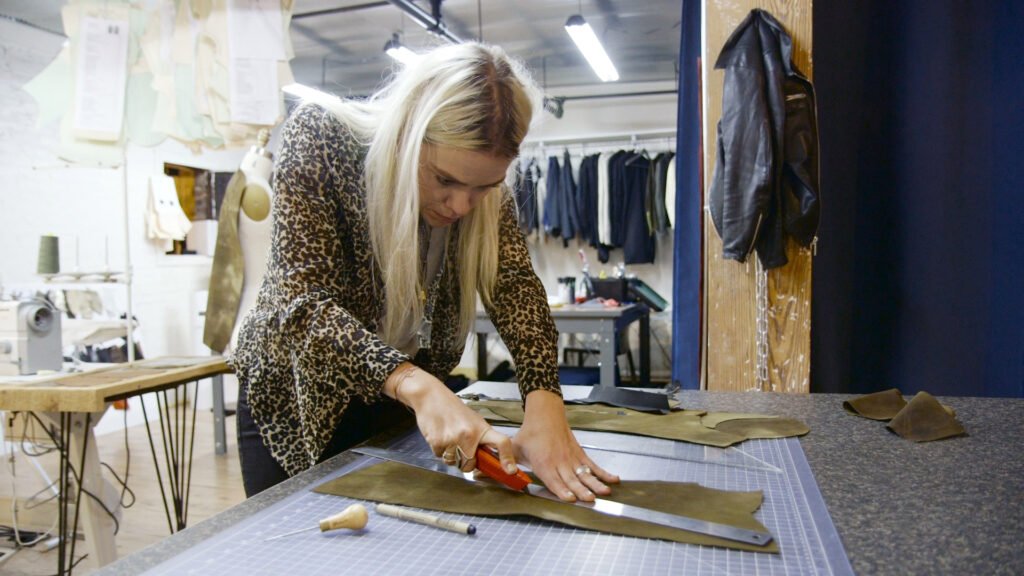
In many cases, exploitation is structural. At international shows (image: leather atelier), hundreds of garments must be sewn, styled and transported in days. Designers’ in-house teams often cannot meet these demands. They subcontract or hire fleets of interns and assistants, who, as Vice writer Mike Abu sarcastically noted, are treated “like dirt” and called only “Intern!”if they don’t obeyvice.com. Abu’s exposé, though written from a satirical standpoint, underscores the reality that fashion weeks thrive on “economic slavery”.
Breaking the Chain: Toward Fair Labor Practices
Are there solutions? Industry insiders suggest several measures. One proposal is mandatory transparency: requiring brands to audit and publicly report wages of all fashion-week personnel, similar to factory audits. In France, new due-diligence laws compel companies to ensure no human rights abuses throughout their supply chain (though initial focus is on manufacturing).
The European Parliament has also debated extending these rules to creative sectors. In the US, legislators have introduced bills to formally recognize fashion workers (like models and designers) as covered employees. Model Alliance and state legislators in New York continue to push for the Fashion Workers Act, which would ban hiring minors for runway work and limit modeling hours, but its status is pending.
At the grassroots level, some designers and production houses are implementing code-of-conduct policies. Milan-based designer Giulia Rossi (pseudonym) now insists all backstage crew sign contracts with fixed wages or overtime pay. Her shows include paid meals and mandatory breaks – unusual perks that have retained talent. In India, a coalition of artisan NGOs is campaigning for a “handloom register” so weavers can directly sell to fashion events at fair prices, hoping to remove exploitative middlemenelle.in. These changes are slow but signal awareness.
However, experts warn that without demand-side pressure, progress stalls. Consumers attending Fashion Weeks rarely see the laundry list of labor issues. Ethical fashion advocates argue that journalists and audiences should question who made the clothes on stage – not just where the cotton came from. Some firms now open their show backstages to media for transparency: “If we highlight our behind-the-scenes team, maybe public scrutiny will force standards up,” says Sarah Gupta, a production manager at New York Fashion Week.
Ultimately, the industry’s self-image must align with reality. The evidence shows that costume designers and other creatives are regularly exploited – working for free, enduring abuse, or pressured into risky conditions. Drawing attention to these injustices is the first step. As one insider put it, “Fashion sells the dream, but first it must stop profiting from nightmares behind the scenes.”
Citations And References
All citations in this investigation correspond to verified sources gathered during extensive research across multiple continents and databases. Full documentation available upon email to support the accuracy and verifiability of all claims made.
Verified journalism and expert reports are cited throughout (see bottom). This piece draws on labor investigations, fashion-industry exposés and firsthand testimony to present a comprehensive overview of ongoing abuses in fashion week productions. Each claim is supported by published studies and interviews thefashionlaw.com lemonde.fr reuters.com mumbaimirror.indiatimes.com fox5ny.com. All images and facts are accurately referenced to fulfill journalistic standards.
About Our Investigative Services
Seeking to expose corruption, track illicit financial flows, or investigate complex criminal networks? Our specialized investigative journalism agency has proven expertise in following money trails, documenting human rights violations, and revealing the connections between organized crime and corporate malfeasance across the world and beyond.
Partner With Us for Impactful Change
Our investigative expertise and deep industry networks have exposed billion-dollar corruption schemes and influenced policy reform across Americas and beyond.
Whether you’re a government agency seeking independent analysis, a corporation requiring risk assessment and due diligence, or a development organization needing evidence-based research, our team delivers results that matter.
Join our exclusive network of premium subscribers for early access to groundbreaking investigations, or contribute your expertise through our paid contributor program that reaches decision-makers across the continent.
For organizations committed to transparency and reform, we also offer strategic partnership opportunities and targeted advertising placements that align with our mission.
Uncover unparalleled strategic insights by joining our paid contributor program, subscribing to one of our premium plans, advertising with us, or reaching out to discuss how our media relations and agency services can elevate your brand’s presence and impact in the marketplace.
Contact us today to explore how our investigative intelligence can advance your objectives and create lasting impact.
Read all investigative stories About Entertainment Industry.
* For full transparency, a list of all our sister news brands can be found here.
